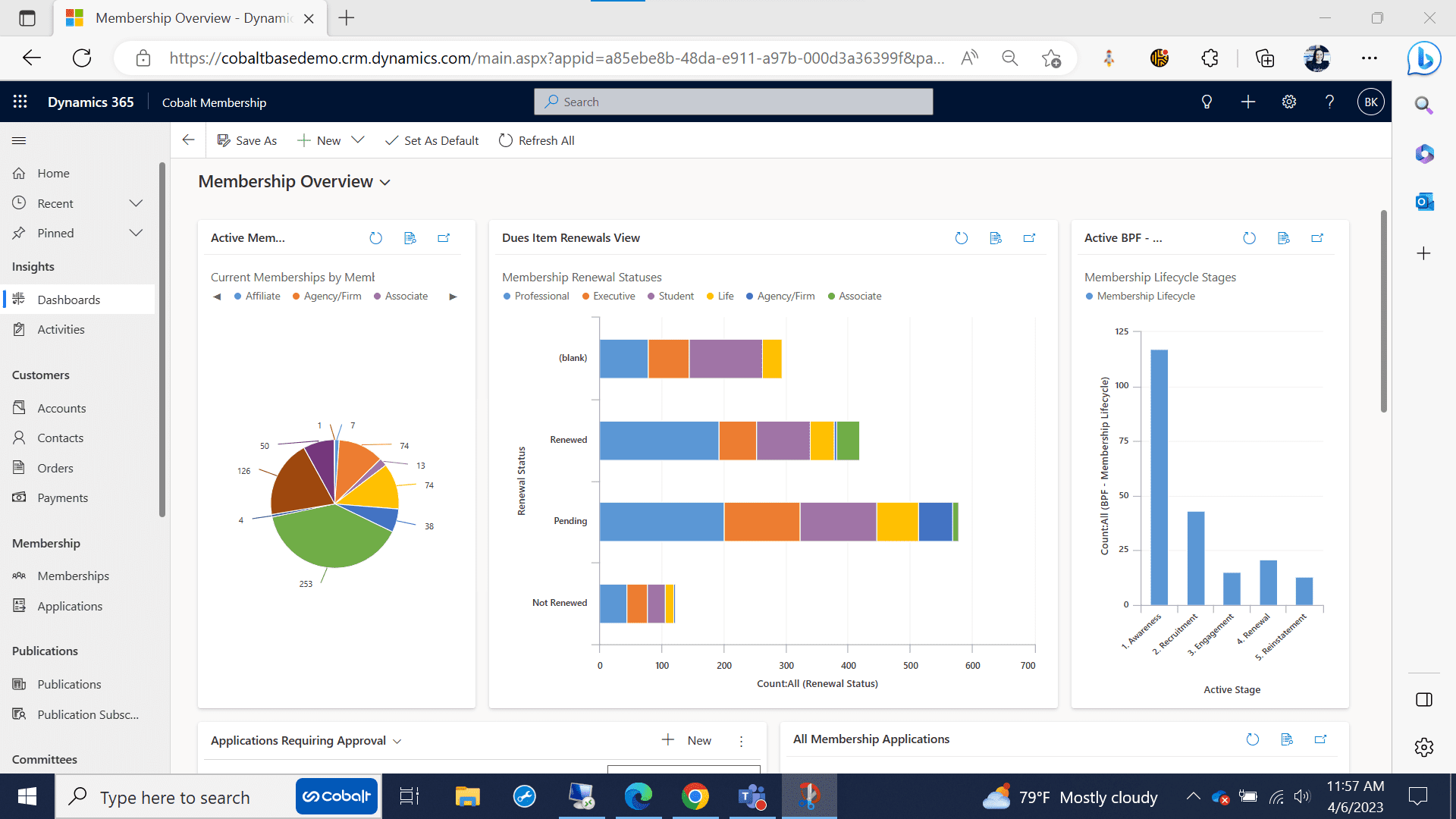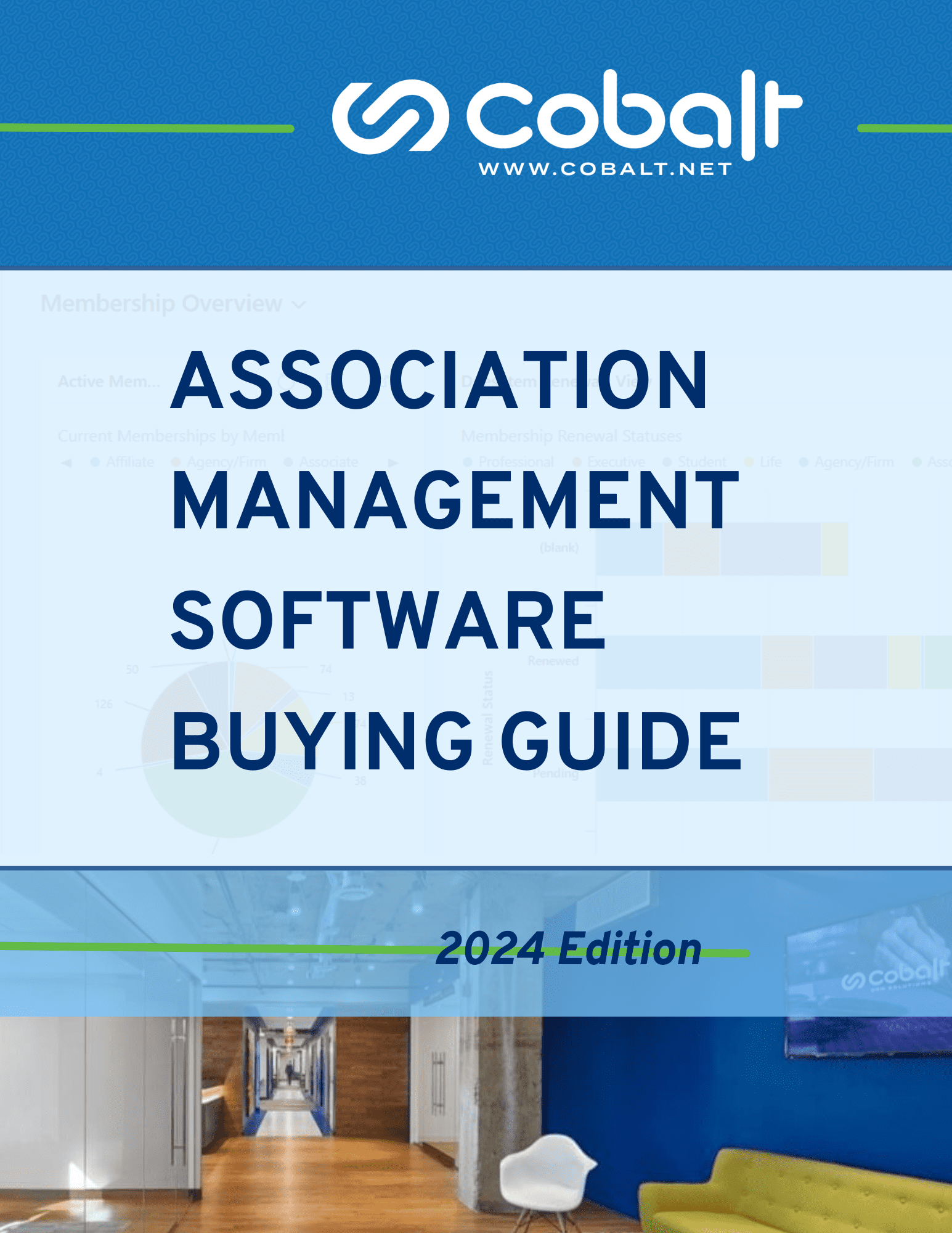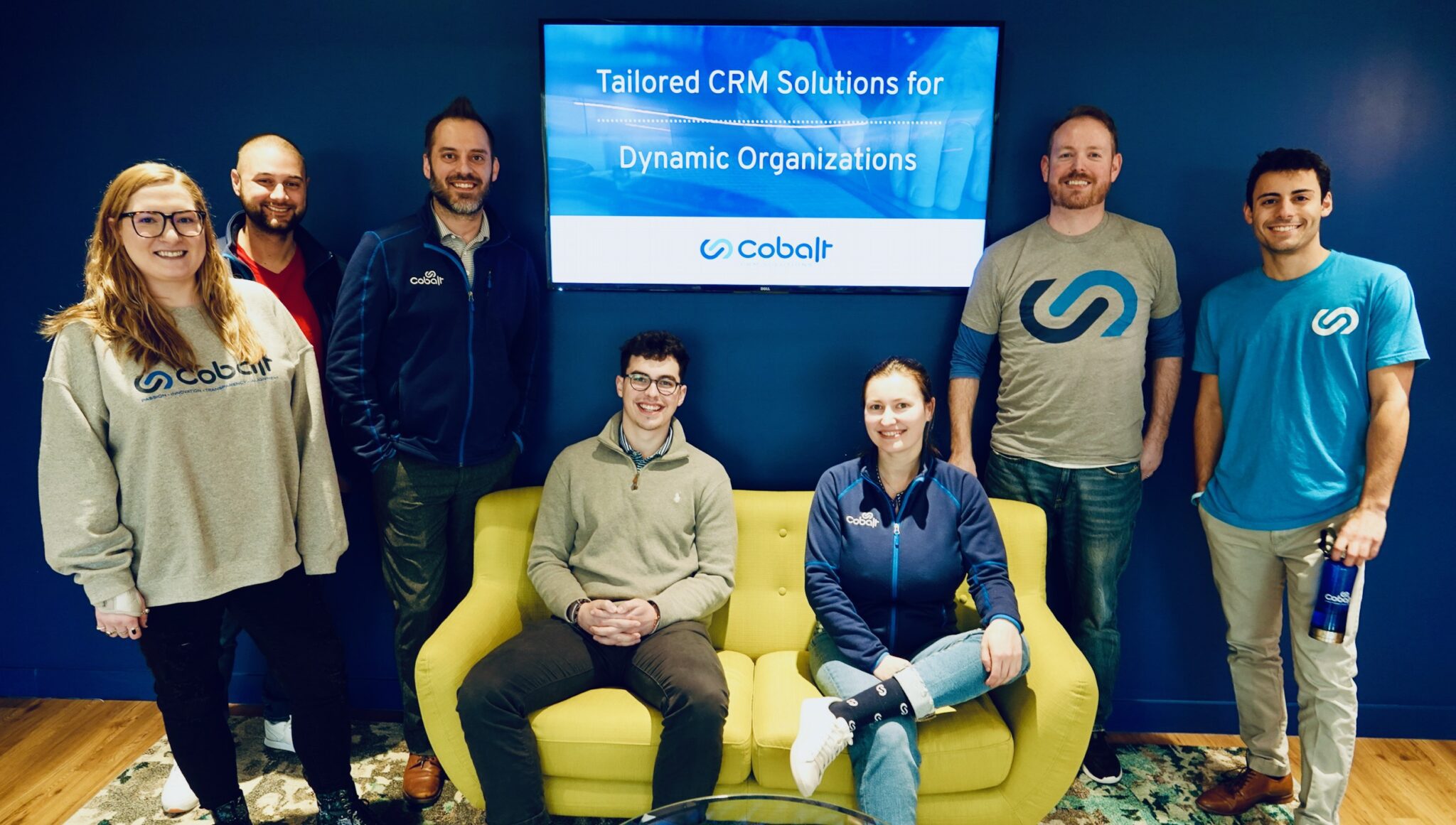AMS Cost Considerations for Associations
AMS cost factors mostly fall into two categories. You’ll need to plan for the upfront cost of an AMS implementation project as well as ongoing monthly license fees. AMS implementation projects can have a huge range of complexity. After 25+ years in the association space, and over 25,000 hours refining our association management software, our team at Cobalt has helped hundreds of associations and certification organizations understand exactly what factors will ultimately affect project timelines and final AMS pricing. It’s difficult or impossible to estimate your implementation without any context, but we can offer some current estimates and these four quick takeaways today.
What Does the Average AMS Cost in 2024?
Before we look at factors that drive up costs and clarify the questions you should ask as you’re budgeting this project, let’s establish a baseline. If you outsource your AMS implementation, have 10-100 association staff members, and your business requirements fall into the light-to-medium range, you should expect to pay $150K – $300K for your AMS implementation, with ongoing monthly costs of $75 – $150 per user.

Budget AMS Options
Maybe your organization doesn’t fit the description above. Or, maybe it does, but you don’t have the budget for association software that’s tailored to your exact business requirements. There are definitely ways to keep this project under the baseline above. Here are some quick considerations for your team.
The customer and the vendor both contribute to the final price of your AMS. The vendor’s costs might be out of your control, but here are two ways you could work to pay less.
The 3 Biggest Factors in AMS Costs
Many factors wind up playing a role in how much your AMS implementation will ultimately cost. However, there are three major considerations that often make the biggest difference.
How Much AMS Customization Do You Need?
One of the first questions you should ask before deciding on a new AMS is “how open is my organization to changing its current business processes based on the software available in the market?” If the last time you shopped for an AMS was even 5 years ago, you will be pleasantly surprised at how much has changed.
New vendors have entered the market and existing systems have evolved to better meet the needs of membership organizations. It’s important to note that despite the changes, it is rare that an out-of-the-box system will meet 100% of your company’s needs. This is when you decide if your company is ready to adapt or customize.
What do we mean when we say adapt or customize? At a high level, it means that your company can decide to adapt to the base product offered by the AMS vendor (keeping implementation costs low), or customize the AMS so that you don’t have to compromise on your current processes (this can lead to significantly higher implementation costs).
How should you decide which option is best? Many associations set a budget for an AMS software implementation project beforehand and let that drive the level of customization they can afford. That’s not necessarily a bad way to go, but there is a strong case to be made for only disclosing 80% – 85% of your projected budget to a prospective vendor.
Migrating Legacy Data Spikes Your New AMS Cost
This is the second major pricing driver for association management software implementations. How much of your existing data do you need migrated to the new system? Please note that we said need, not want. Cobalt frequently spends hundreds of hours (and tens of thousands of our clients’ budget dollars) because a customer is afraid to leave any data behind. We end up migrating data that will likely never be used on a regular basis.
It really doesn’t need to be that way for your team. One great compromise that our customers appreciate is to copy older and less frequently used data straight into the new system without transforming or mapping it. This can simplify the process, save time, and reduce costs by not trying map fields that no one has used for 20 years. You can also simply keep a backup of your previous system. This approach allows you to migrate that data later if you realize that you need it.
Who should decide which data you migrate? Our approach is to listen well and listen early in the process to your team’s heaviest AMS users. How are they using your current AMS software? What are their top or most frequent day-to-day tasks? If you do a good job of mapping those needs out, along with your top business requirements, you should have a trustworthy start on flagging essential data. This is something we’re happy to talk more about in a free assessment and consultation with your team.
Spread Your AMS Costs Out
The initial complexity of your new system is the third big factor for teams trying to sort out how much to spend on their next AMS implementation. What do you really want your new system to have? Your staff members may already have a list of requirements they have been compiling for years, especially if it has been a while since your last AMS upgrade.
Cobalt is an AMS vendor with the kind of deep experience to build anything your team could want. We know the temptation to implement all of those ideas into your shiny new AMS might be strong. But you should proceed with caution. Here’s why.
You have likely been making tweaks to your system for several years in order to get it to where it is today. With that in mind, we strongly encourage customers to take a phased approach to any AMS implementation. This will reduce your upfront cost and risk while still providing a success story for your staff, your members, and the Board. Once the system is in place and can carry out the main functions you need, you can add the nice-to-have features over time.

Things have changed tremendously since the early days of proprietary, closed systems. Integrations, updates, upgrades, and more can happen very quickly, or even automatically. Open API systems like Microsoft Dynamics 365 mean adding custom association software solutions like Cobalt’s Engagement Dynamics are significantly faster and more cost-effective than they were 10 or 15 years ago. And with a partner like Cobalt, adding new features or out-of-the-box functionality from the Power Platform a year or two after your AMS implementation is easy.
Other Significant AMS Cost Considerations
The three areas we’ve already listed will almost certainly have the biggest impact on the final price tag of this project. Here are some other critical AMS cost considerations to keep in mind as you’re planning.
Software License or Subscription Fees
Software license or subscription fees play a pivotal role in your recurring AMS costs. These fees, often structured on a per-user basis, determine the accessibility of the system across your organization. A key consideration is ensuring that licenses are allocated judiciously, aligning with the actual user needs. Not everyone in the organization may require a license, and understanding this balance is crucial for optimizing costs while ensuring widespread access to the AMS.
The driving engine under Cobalt’s AMS software is Microsoft Dynamics 365. You have a tremendous amount of flexibility in the user licenses within the Microsoft ecosystem, which is one of the reasons it’s so much more affordable than Salesforce and other enterprise CRM solutions. But, that complexity also means teams can wind up paying more than they need to each month. Navigating the many-layered Microsoft licensing options and optimizing our association partners’ monthly expenses is one of the niche services Cobalt offers.
Implementation and Set Up Costs
The implementation and set up costs for association software extends into the strategic planning and project management domain. In-house project managers contribute significantly to this phase, meticulously planning each step of the implementation journey. Their time translates into costs during this process, which underlines the importance of efficient project management. Streamlining the set up while adhering to the budgetary constraints will affect your final AMS cost. There may also be physical hardware that must be purchased for on-premises AMS implementations.
Initial and Ongoing Training
Training is a cornerstone in the successful adoption of a new AMS within organizations. This critical phase goes beyond introducing users to the interface; it’s about empowering them to leverage the system effectively. The investment in training pays dividends as staff members become proficient, fostering a smoother transition and maximizing the benefits of the new software. It’s not merely an expense but an essential step toward unlocking the full potential of your AMS system and getting the most out of this investment.
Support and Maintenance
While not strictly a part of your initial AMS implementation, this project is the time to understand and set expectations about ongoing support and maintenance for your system and staff. This is how you can ensure you’re getting a flexible system and vendor support to align your AMS with your evolving organizational needs. Unresponsive AMS vendors, or support teams who couldn’t really address issues and requests are some of the most common complaints and frustrations we hear about as we meet new association partners.
You may not feel like you need it now, but a time will come where support is a necessity. Cobalt provides unlimited ongoing support to answer all the “How do I …?” kinds of questions for trained end users with our association partners. Read more about our industry-leading support agreement, AMS support response times, and customer satisfaction ratings with our association software overview.

Integrations
Most organizations often require a network of interconnected systems for comprehensive functionality. Integration stands out as a key driver influencing AMS implementation costs. The need to seamlessly connect your AMS with external providers or other software, such as exam services or learning management systems, underscores the importance of a robust integration strategy.
Choosing an AMS vendor like Cobalt who offers a deep array of out-of-the-box integrations can be a strategic move to optimize costs without compromising functionality. For more information on this one, check our our blog on what your AMS should do. We’ve outlined the core AMS functionality you’ll probably need, and what you’re better off integrating through a third party application.
Modern AMS solutions often offer enhanced functionality through additional features or modules. Cobalt’s AMS solution, built on top of Microsoft Dynamics 365, has extremely robust flexibility. Evaluating the potential of these add-ons is a strategic exercise in optimizing costs and maximizing value. Consideration should be given to whether a compatible add-on can effectively replace existing solutions at a lower cost. This approach aligns with a prudent financial strategy. Each additional feature contributes measurably to your organization’s goals, making the investment a meaningful, purposeful advancement, rather than merely an addition.
Negotiating AMS Cost and Budgets
(5 Proven Best Practices)
Let’s wrap things up in this post with five of the most essential pieces of advice we can offer your team when it comes to setting your budget and AMS cost range for your new system. Any of these should help you navigate the complex process ahead with more confidence.

One AMS Cost Red Flag
Beware of software vendors that try to give you an exact, upfront price for a custom, agile AMS implementations. The reality is they’re either not telling the truth or they might not have had enough experience yet to understand a project this complex.
Okay, it’s not necessarily a red flag, but we’ll say it’s at least a strong yellow! Be cautious and most importantly, don’t be afraid to challenge how they’ve arrived at such a precise AMS cost.
Outliers Are Often Just Liars
If you start pricing AMS systems or sending out some version of an RFI, RFQ, & RFP to vendors and someone comes back with a much lower estimate, that’s another cause for concern. Cobalt has been competing in this market since 1996. Vendor prices for an AMS should be within 10 – 20% of one another. Any lowball offer is hiding additional costs the vendor doesn’t want to reveal upfront — or they don’t actually understand what you do. Take a few minutes to review our post on a better CRM RFP process — it has some great tips that will help with your next AMS RFP.
Don’t Set Your AMS Budget in a Vacuum
Arbitrarily setting a budget almost always creates unwanted complications for associations. If you settle on an ironclad number up front, then every step in the rest of the process becomes about trying to see how many features you can get for that price. The hidden problems soon emerge, though.
The biggest one we run into with our clients is that as we get midway through scoping their implementation. Sometimes they find out we have features and benefits they didn’t know about beforehand — but discover they could really use! Then it becomes a painful process of eliminating other items they want or need to accommodate the budget ceiling they were already up against.
Hold Something Back in Your Budget Conversations
When you do settle on an estimated budget — keep it to yourself. It might be best to not even tell all of your internal stakeholders, especially business users. It may sound like loaded advice for a vendor to offer a prospective client, but we believe it works better for everyone if you know what you can spend but hold something back in your conversations.
Based on our long history with associations, you should hold back 15 – 20% of what you can actually afford to spend. When you set your ideal AMS cost low with your vendor to give you wiggle room as the project develops, and it will go much easier for everyone.
Any good vendor will include a 10 – 15% contingency in their proposals and estimates. So, this will give you the flexibility you need to adapt to changing priorities and requirements as you navigate your implementation.
Gain Budget Confidence Early
When you loop trustworthy vendors into the conversation early, you can be a lot more confident about what you’re paying for and what your AMS will really cost. We suggest that you don’t even go to your decision makers and ask for a budget for this project until you’ve talked with vendors in the market to get an idea of what’s available and realistic.


